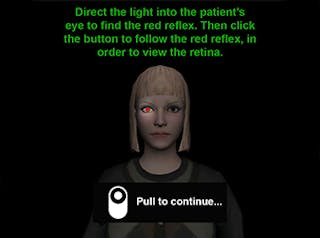Virtual Reality eye examinations

Eye examinations can provide important ‘early warning signs’ of many medical conditions but it can be a challenge for doctors to learn this procedure and find suitable patients to practice on. Computing experts from the University have devised an innovative solution to this problem by using Virtual Reality technologies.
Researchers
Dr Andrew Sean Wilson and Jake O’Connor
School of Computing and Digital Technology
Background
Eye examinations are an important method used to provide early diagnoses of underlying medical conditions such as haemorrhages, diabetes or raised intracranial pressure (potential brain damage). They require a doctor to use specialised equipment to shine a light directly into the eyes of a patient to look for potential problems in the back of their eye.
It can be difficult for trainee doctors to find patients to practice learning the specific examination procedures on, making it hard know what key indicators of health issues look like. If performed incorrectly, this type of examination can also cause discomfort for patients.
Aims of research
Dr Andrew Wilson from the University collaborated with doctors at City Hospital, where their medical director explained the challenges facing trainee doctors around their learning how to perform eye examinations.
The difficulties often come down to the fact that, while learning how to perform these eye examinations, they are unsure of the correct processes. They are unfamiliar with what the should be looking for in the eye and, if not trained correctly, patients can find themselves put through a level of discomfort. This means that many of those chosen to practice on were healthy colleagues, which makes it impossible to replicate the conditions needed to identify illnesses.
Method of research
Academics Dr Andrew Wilson and Jake O’Connor, from the School of Computing and Digital Technology, worked alongside doctors and medical students at Birmingham City Hospital to create the new system.
This innovative application uses a combination of both mobile phone and a virtual reality headset to show enhanced, close-up and moveable images of an eye’s interior to allow users to learn how to perform the correct systematic diagnostic procedures used when performing routine eye examinations.
Outcomes
This new innovative virtual reality tool allows medical students and trainee doctors to replicate eye examinations and learn first-hand how to diagnose hard-to-spot conditions which may otherwise go unnoticed. It provides the opportunity to use authentic clinical images, 360 views and descriptions from experts (ophthalmology) in the eye to teach how to replicate the conditions of a real-world examination instead of still photographs.
Currently the app is routinely used to support traditional teaching of medical education at Sandwell and West Birmingham Hospitals Trust, and medical professionals across Europe and as far away as South America and Indonesia are already making use of the application too.